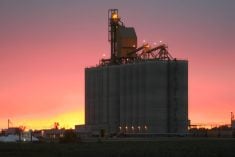As kids, one of the first things we learned about dairy cows is they have four stomachs! It was inconceivable they would need all those stomachs to eat and digest food, but we were later taught dairy cows have a truly special digestive system. In particular, its special fermentation vat or rumen, gives them the unique ability to digest fibre in forages. Consequently, most dairy producers know forage fibre is the foundation for good health and milk performance in lactating dairy cows and should always be provided in sufficient amounts.
Read Also

Cancer agency reclassifies another herbicide ‘probably carcinogenic’
The WHO’s cancer research agency has now put atrazine, a herbicide well known to corn growers, in the same potential-hazard category where the agency put glyphosate.
Believe it or not, fibre from forage or any other feed is not a true nutrient for dairy cows as compared to other essential nutrients such as energy, protein, minerals and vitamins, but there is a requirement for it in the milking cows’ diet, just the same. Specifically, it’s the longer forage fibre particles or “effective fibre” that maintains a healthy population of feed-fermenting and nutrient-digesting rumen microbes by activating regurgitation of ingested feed, better known as cows “chewing their cud.”
Cud-chewing cows release sodium bicarbonate into their saliva, which is the primary buffer and first-line defence against dangerous digestive acid buildups and thus keeps the cow’s entire gut in good working order. A lack of dietary fibre can irreversibly upset this natural order and may lead to: reduced feed intakes, poor feed digestion, sub-clinical rumen acidosis (SARA), feet and leg problems, butterfat depression and ultimately poor milk production.
Lactating dairy cows fed sufficient digestible effective fibre can spend up to 12 hours/day chewing their cud. It is commonly suggested dairy producers follow these 10 respective recommendations to maintain consistent cud-chewing and proper digestion:
1. Regardless of milk production, manage the forage to concentrate ratio (grains and protein supplements) between 40:60 and 60:40, respectively.
2. Provide 28 per cent NDF (neutral detergent fibre) in the whole diet with 75 per cent of this NDF coming from forage sources and at least of 19 to 20 per cent ADF (acid detergent fibre).
3. Forages should be chopped at a cut length of 3/8-inch to 1/2- inch to provide 15 to 20 per cent of the dietary particles being over 1-1/2-inches long that is thought to create a good rumen mat, essential for efficient feed fermentation.
4. On a practical basis, include 2.0 kg per head of long-term hay in total mixed ration (TMR) to assure that adequate “effective fibre” will be met.
5. Maintain fermentable carbohydrates (namely sugars and starches) to less between 33 to 38 per cent of the diet depending on the level of forage fibre provided.
6. Control the amount of added unsaturated fats (re: vegetable oils and fats) to 300 g/per head/day. This type of fat tends to be toxic to forage-digesting rumen bacteria. Limit feed total fats to five to six per cent of the diet (dm basis).
7. Do not under-or over-mix the entire TMR to prevent sorting or creating too many fines. Research shows that optimum mixing time is between four to six minutes.
8. A dry TMR has a relatively low physical density and makes it easy for the cattle to sort. Add water to bring up the moisture content of a lactating TMR between 45 to 50 per cent.
9. Assure all cows have adequate bunk space, are fed at the about the same times each day and don’t expect all the cows to eat every last morsel. A well-picked over feed refusal rate between three to five per cent is normal.
10. Provide sodium bicarbonate as an option, either in the diet or free choice to assist rumen buffering, especially when effective fiber is limited.
Unless we are lucky enough to ever see cannulated cows, often found in research herds, we won’t actually see forage fibre at work in the rumen. Invisible to most of us, when a cow eats a ration and feed enters the rumen, it gets pushed into an existing “rumen mat,” which is a thick floating mass of partially degraded long particle forage fibre.
The rumen mat is the main site of forage digestion, much of the resident forage-fermenting microbes adhere to ingested forages, ferment and extract their available nutrients that will eventually be turned into milk (including milk fat and protein) in the udder. It is also the source of important long-stem forage fibres routinely regurgitated for cud chewing into smaller pieces, which are swallowed again for further microbial processing.
To determine whether a dairy diet forms a rumen mat of adequate size and stature in a “working rumen,” apply this practical test during a barn walk through.
First, take a look at most milk cows a couple of hours after eating. At least half should be resting and chewing their cud. If cud chewers are difficult to spot, the herd (focus upon the early and high milk producing cows in a split herd) might be consuming a low forage fibre diet. A herd of cud-chewing cows usually appear very relaxed, and yet bright eyed.
Also look at the tail end of these cows. Their manure consistency tells us a bit about the ingredient profile of their diet as well as how it was digested. Manure from cows on a well-balanced ration (with adequate effective fibre) is very uniform with the consistency of porridge. It contains digested feed particles with the majority of particles no greater than 1/2 inch, and low amounts of undigested grain. If a cow pile is littered with long-stem fiber or grain, it could be a sign of inadequate dietary fibre.
Last, perform a quick objective test on the amount of effective fibre provided in the ration (only works with TMR), even before it is fed to the dairy herd. A representative sample of dairy diet is simply collected and put in a bucket of warm water. If about 15 to 20 per cent of the ration floats, there should be enough forage fibre in the diet. Otherwise, if nearly all of the diet sinks to the bottom of the pail, consider reformulating this ration by adding more long stem fibre. This is a board demonstration and to more exactly measure fibre it might be worth investing in the widely accepted Penn Particle Separator.
Avoid feeding too much or the wrong forage fibre — a high lignin fibre (which is indigestible by dairy cow).
PeterVittiisanindependentlivestocknutritionist andconsultantbasedinWinnipeg.Toreachhim call204-254-7497orbyemailat [email protected]















